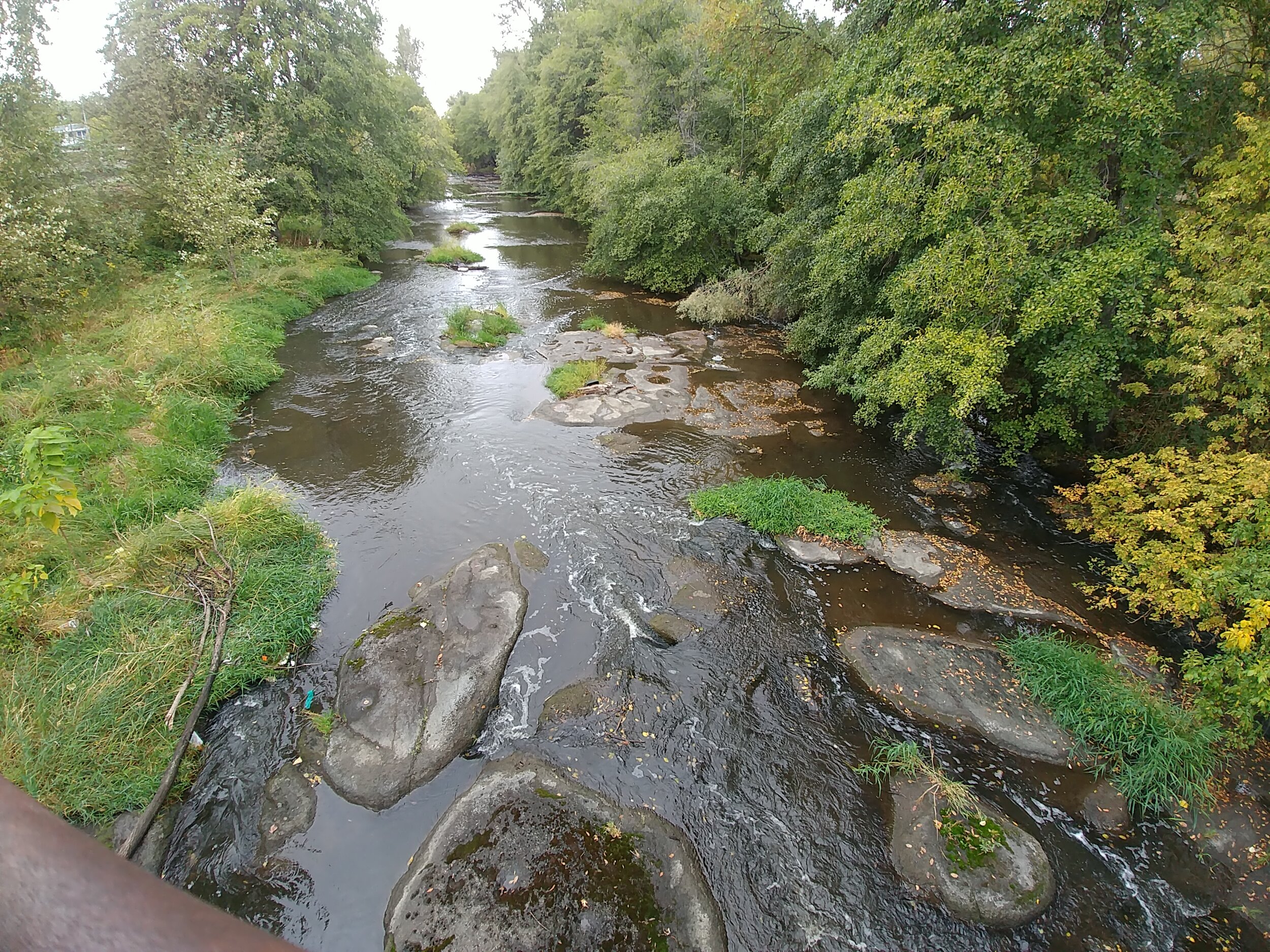Good Work Continues on Bear Creek
For some of us, Bear Creek is a natural resource that can often be taken for granted. It runs through many of our towns, is adjacent to businesses and homes, and has unique beauty as well as urban issues. For others, Bear Creek restoration and revitalization is at the top of the priority list! At Rogue Riverkeeper, we often hear from the public asking questions about the health of Bear Creek and what local entities are doing to restore it after the recent fires.
Simply put, fires drastically change landscapes. On September 8, 2020, residents of the Rogue Valley experienced firsthand the intensity of a fire related evacuation and the devastating aftereffects of the Almeda fire that swept through the Bear Creek corridor from Ashland to south Medford, and the South Obenchain fire impacting the Rogue near Shady Cove. In just hours, fire reduced nearly all of the vegetation lining Bear Creek - and surrounding homes and structures - to ash. The South Obenchain fire burned mainly forest and agriculture land. While community members and organizations came together to provide immediate relief, support, and mutual aid to those people most impacted by the fire - local agencies, municipalities, nonprofits, and consultants (focused on natural resource management) sprang into action as well!
How do fires impact rivers?
When water flows over burned structures, it can pick up anything that was exposed in the fire, including lead paint, pesticides, plastics, rubber, solvents, and asbestos. In the short-term, these harmful materials can get washed into local rivers and streams, which can be toxic to humans and fish. Runoff from burned trees and grasses can also carry high levels of nutrients, which can lead to harmful algae blooms. In the long-term, high severity fires that burned trees and shrubs can leave bare soil behind, which can become unstable during rainy weather causing erosion and increased sediments entering waterways. More sediment in our streams can harm fish, pollute drinking water sources, and can smother gravel in streambeds that salmon use for spawning. Additionally, less stable hillsides may increase the likelihood of dangerous mudslides. [Read more…]
Who is addressing these impacts?
In days after the fire, Rogue Riverkeeper along with a robust team mobilized to discuss revitalizing the Bear Creek waterway and adjacent vegetation (i.e. riparian corridor). With the Almeda Fire occurring in the beginning of fall and rains on the way - our team immediately focused on how to 1) keep polluted stormwater from reaching the creek, and 2) stabilize Bear Creek streambanks from eroding into the waterway. Through weekly meetings, we discussed current restoration efforts, water quality monitoring needs, and how to take action to protect our waterways.
Water Quality Monitoring
Biobags installed in Phoenix.
Immediately following the fire, our primary focus was on understanding where potential water pollutants may be coming from, and how to keep those pollutants from entering streams. We monitored weather closely to see when the first storms with significant rainfall (and runoff) may arrive. Rogue Valley Sewer Services , an agency that manages stormwater and wastewater in the Valley, was instrumental in managing stormwater runoff by quickly installing “biobags”, catch basin inserts, and wattles on public stormdrains to filter water as it entered the facilities.
Testing water in both Bear Creek and mainstem Rogue was also a top priority. While Rogue Riverkeeper monitors Rogue River Basin waterways during the summer months, Rogue Valley Council of Governments - Natural Resources Division, Jackson County Watermaster, and Medford Water Commission test our local waters for pollutants (or indicators of pollutants) year-round. Post-fire, these agencies increased the frequency of their sample days, as well as increased the number of sample sites. Rogue Riverkeeper was able to offer support to help with this increased monitoring looking for changes in turbidity (e.g. cloudy water), temperature (e.g. warmer water), phosphorous, conductivity, and volatile organic compounds (VOCs).
While RRK’s and ODFW - Fish Division scope of work tends to have more focus on water quality impacts to instream wildlife (salmon!), the City of Grants Pass - Public Works and Medford Water commission are committed to providing safe drinking water to our municipalities. Both agencies increased the number of water sample sites on the Rogue (above the drinking-water intake), and on Bear Creek where it enters the Rogue. It’s the time of year where the Medford Water Commission no longer draws water from the Rogue and relies solely on Big Butte Springs.
Riparian Restoration
The riparian area, the vegetated buffer on either side of waterway, is an extremely important ecological component to the health of a river! Trees and shrubs in this zone provide shade to keep water cool, insects for birds and fish, and root systems that stabilize streambanks. They also act to filter water that may run into the creek keeping out potentially harmful pollutants.
After the Alemda and Obenchain fires, riparian areas were left almost completely bare. Jackson County Roads and the Oregon Department of Transportation quickly moved to temporarily close the greenway to keep users safe from potentially hazardous trees and smoldering brush. These agencies were tasked with marking and felling trees that could impact the greenway and roadways. While some tree material was removed off-site, much of the woody debris remains to rebuild soil in the future. When feasible, downed trees and rootwads were allowed to remain in the creek to create habitat for fish and wildlife (including beaver!)
Next, a massive effort was put forth to reseed the greenway and stabilize soils and streambanks. Working in conjunction, Jackson County Parks, ODOT, and the Rogue Native Plant Partnership, curated a seed mix best suited for our region, and distributed them along the greenway in zones marked high, medium, and low priority. Lomakatsi, a local nonprofit that installs restoration projects, was contracted to install straw wattles and spread straw over large portions of the riparian area. Rogue Valley Sewer Services contracted for hydroseeding of steep slopes on tributaries to Bear Creek and in the Table Rock fire riparian area. Rogue Riverkeeper used our volunteer resources to partner with Jackson County Parks to organize hundreds of volunteers to spread straw in additional areas over the new seeds alongside streams to keep sediment from reaching the creek during heavy rain.
What’s happening now?
While recently out on the greenway with a volunteer during a rain event, I came across our regional representative from Department of Environmental Quality - Water Quality division biking the trail to look for cloudy/turbid water, and see how the recent restoration efforts were holding up. My volunteer and I were doing the same! And as the day progressed, we ran into other agency staff “getting eyes on the creek” monitoring the health of the water and riparian areas. So many folks caring about Bear Creek restoration!
Teams continue to meet weekly to discuss the health of our waterways. Analyzing the results from water quality monitoring, storing the data, and determining how to get information out to the public is in progress. The agencies keep a sharp eye on parameters that could indicate poor water quality and are ready to take action to keep us safe. Many staff and volunteers are walking the greenway, snapping photos, and taking note of areas that need attention. In an attempt to keep blackberries from returning, Jackson Soil and Water Conservation District has provided funding for herbicide application on blackberries.
Rogue Riverkeeper recently started a new volunteer-run photomonitoring program to visually capture changes to the greenway over time. Volunteers are given specific photopoints to monitor every month, taking photos of the riparian areas upstream, midstream, and downstream, then organizing the images for future use. Images are accessible to all agencies.
Rogue River Watershed Council, a nonprofit that promotes stewardship of the Rogue through restoration, education and community involvement, is taking the lead (along with Jackson County Watermaster) to oversee Southern Oregon University student projects that focus on collecting additional water quality data and measuring restoration effort effectiveness.
It’s inspiring to see the effective coordination, energy, and work being done by our local entities to preserve and restore Bear Creek and areas of the Rogue. Keep in touch on Rogue Riverkeeper’s social media, email Sara@RogueRiverkeeper.org with questions or concerns, and follow the links above to get connected to local agencies.
For the Rogue!
Media/video on Bear Creek Restoration
Volunteers needed to help prep Bear Creek Greenway for winter
Students come from Klamath Falls to help clean up Bear Creek Greenway
OREGON OUTDOORS VIDEO: Bear Creek Greenway Restoration Part I and Part II














